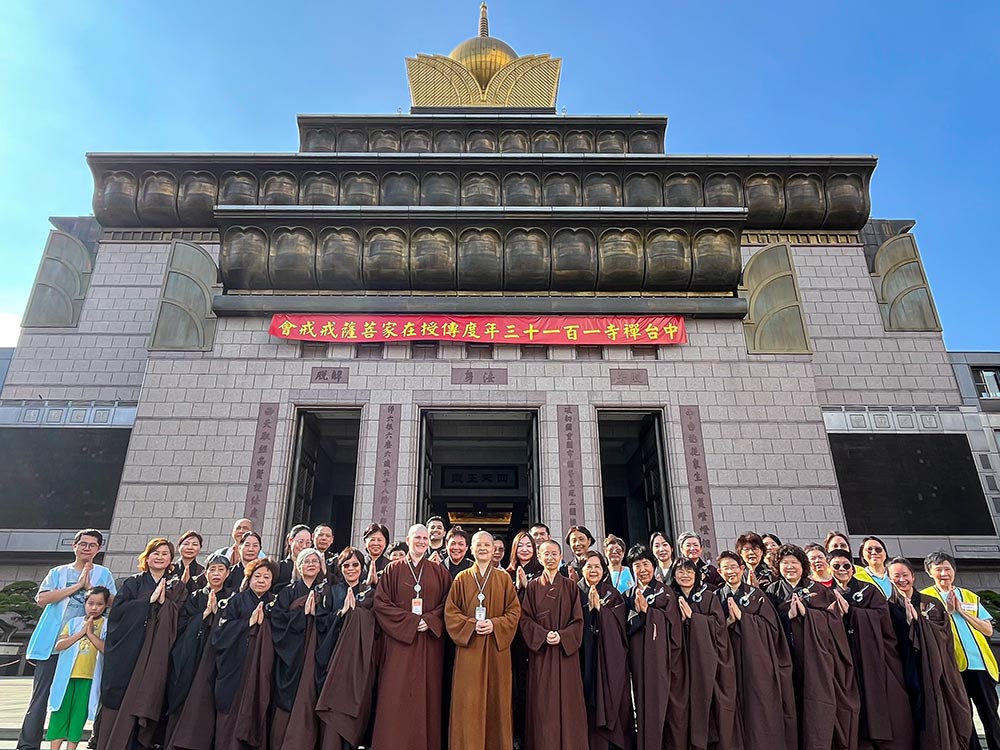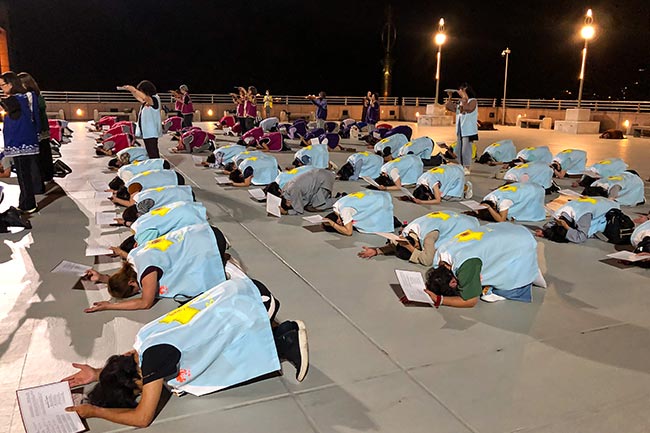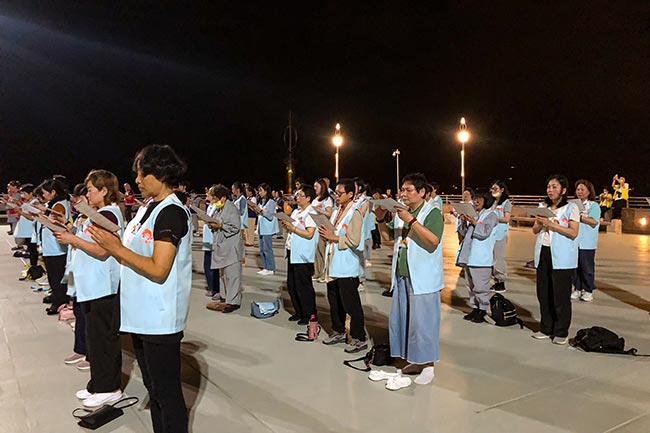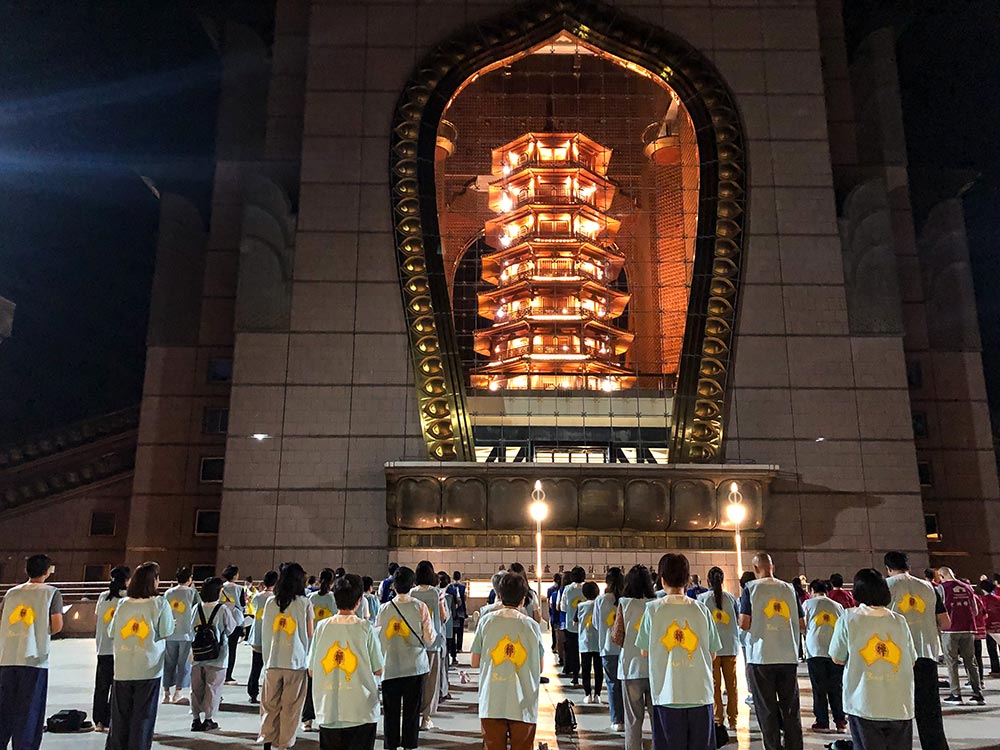

Ivy Chan (Fa Tian) – Level 3, Bao Lin Chan Monastery, Australia

It felt like a blessing beyond measure. In just my second year of study and practice at Bao Lin Chan Monastery, I had the precious opportunity to join my fellow practitioners—whom I deeply respect—in attending Chung Tai Chan Monastery’s Precepts Transmission Ceremony assembly with thousands of Buddhist practitioners from around the world. Although I had a glimpse of Chung Tai’s rigorous yet compassionate ethos through Bao Lin’s dedication to precision, being there in person moved me deeply. I was touched by Chung Tai’s meticulous operation, the warmth and care of shifus, and the unwavering diligence of the volunteers. I came to understand why practitioners who received precepts seven years ago return here with such devotion, strengthening the vows they took.
Stepping for the first time into the dormitory area, I was impressed by meticulously organized spaces. Ultimate compassion for all sentient beings is gently penetrated into every single detail at Chung Tai. The eco-friendly and minimalism setting reduces potential distractions to a minimum. Despite the huge number of people, Chung Tai’s serenity was undisturbed; its careful planning and organization allowed each of us to calm our minds, and free ourselves from mundane worries. During traffic peak, with shifus and volunteers’s swift and quiet guidance, thousands of attendees flowed calmly along cleverly designated pathways, moving with harmony. Shifus, ever-respectful, silently watched over us, guiding those who lost their way back on track, embodying the boundless compassion of Kshitigarbha Bodhisattva (Bodhisattva Earth Treasure).


From the start of the precept transmission ceremony, silence was required. Even the most talkative practitioners kept silent for three days and two nights, out of reverence for the profound vows they were about to take. This silence was not merely about keeping our physical voice quiet; it was a chance to hear the voices within. Without spoken words, we could discern our scattered thoughts that would otherwise be left unnoticed. Even more beautifully, this shared silence dissolved the barriers of language and culture, creating a space free from social pressures. The peacefulness within and without, like melted snow, nourished our hearts and minds.
On the second day, as I observed silence while eating, I realized that each movement of my chopsticks swept away a wave of wandering thoughts, revealing the practice of eating without distraction. After meals, I would close my eyes and focus, waiting to hear instructions before taking any action, even though the bag for wrapping utensils lay within reach. This restraint was partly because I knew others around me might still be meditating, and partly because taking one’s cue from others might stir inner thoughts. The volunteers and shifus had thoughtfully designed action flows and following them minimized the need for them to repeat instructions. Even the simplest gestures became precious opportunities to practice mindfulness—responding only to what was necessary, and refraining from uncalled-for thoughts. In a modern world that prizes efficiency and control, we often take charge of every detail in our surroundings. But at Chung Tai, all the tasks were seamlessly shouldered by the team, leaving us with the simple purity of step-by-step practice.
Complementing the quietness of participants was the calm humor of the Dharma teachers. Master Jianmian’s instructions were succinct, often ending with words that perfectly joined the laughter of the group. His steady calls of “Now, action!” guided us to act with poise and kindly improvised the translation of his words to support international participants. Master Jianda, in his teachings, often had us repeat phrases, which initially seemed like his personal style. But later, during the formal bodhisattva precept transmission ceremony, I realized that he was teaching us to follow his words aloud—these seemingly simple practices were actually subtle preparatory work. Precept Master Jiandi’s serene explanations provided us with an initial but profound understanding of the precepts. The Dharma talks by Venerable Master Jianying, Abbot of Chung Tai Chan Monastery, were as always down-to-earth yet profoundly inspiring.
Transcending our attachments to external stimuli and abiding in pure mind is the essence of mind training, the heart of upholding the precepts. In the solemn precept hall, adorned with wisdom words, the vows felt even rarer and more precious, as we participated in the rituals and teachings, gradually finding peace of mind.
On the evening before formally receiving the bodhisattva precepts, we made an incense offering to the Buddha, setting aside attachments to the self. This gesture of offering, a practice as old as it is profound, reaffirmed our commitment to the Bodhisattva Way. Unlike a tattoo, which inscribes personal meanings visibly onto the body, the incense scars from our offerings serve as a silent, ongoing reminder of our vows across lifetimes—a reminder that we walk this path alongside countless other bodhisattvas and that we are not alone. The same vow brings us together across oceans and unites us again as we return to worldly life, unswervingly committed. To arouse and sustain the bodhi mind is no easy feat; it is a journey for eons until our bodhisattva deeds are perfected to reach buddhahood for the benefit of all. Thus, we continuously remind ourselves and each other of our vow, regardless of circumstances. And yet, on this path of benefiting sentient beings, we are truly one. Appearing as varied identities and forms, we take rebirth again and again, meeting as classmates, partners, and companions in practice. Although our bodies differ, our vows remain one.
Before entering the precept hall, I asked myself repeatedly, “Why do I want to receive the bodhisattva precepts?” At first, my answer was that in this age of degeneration, the precepts serve as our guiding teacher, the foundation of our practice.
But when I am standing in the precept hall in person, that answer sheds its formal layers, leaving only the feeling that this is simply what bodhisattvas do—as natural as breathing while walking. To receive the bodhisattva precepts is a reunion among bodhisattvas.
In the precept hall, we say
-“Ru Shi Pu Sa Fou (Are you a bodhisattva)?”
-“Shi Pu Sa (Yes, I am)!”
In the echo, I heard
-“Hello, bodhisattva—are you still there?”
- “Yes, I am!”

A Selfless Resolve Sets off a Bright Journey